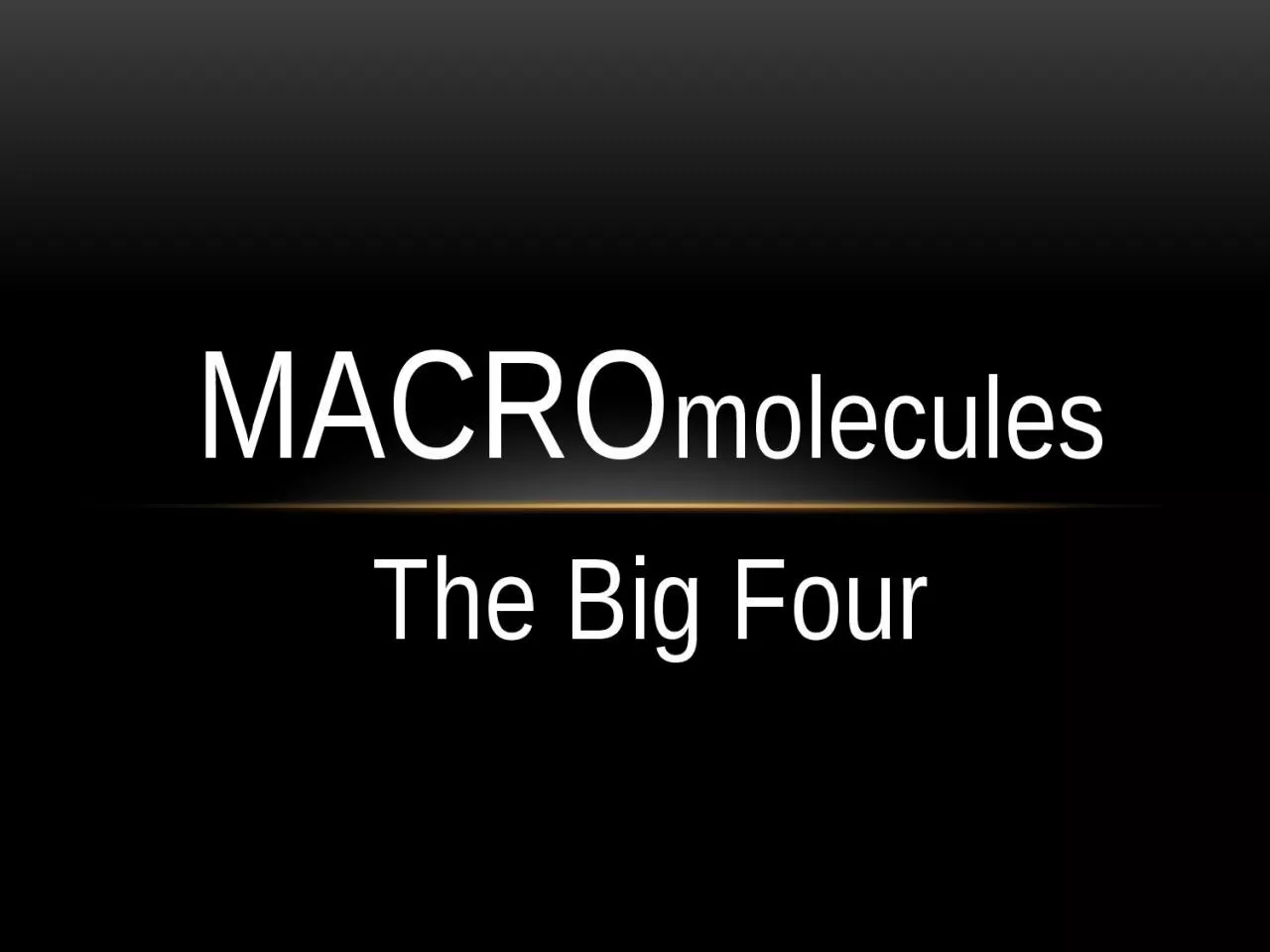

Why are Macromolecules important to the Human Body Macromolecules are essential to the functioning of the human body Carbohydrates are the bodys main source of energy Lipids provide stored energy reserves This allows us to survive when carbohydrates are not being supplied to ID: 1032630
Download Presentation The PPT/PDF document "MACRO molecules The Big Four" is the property of its rightful owner. Permission is granted to download and print the materials on this web site for personal, non-commercial use only, and to display it on your personal computer provided you do not modify the materials and that you retain all copyright notices contained in the materials. By downloading content from our website, you accept the terms of this agreement.
1. MACROmoleculesThe Big Four
2. Why are Macromolecules important to the Human Body?Macromolecules are essential to the functioning of the human body. Carbohydrates are the body’s main source of energy. Lipids provide stored energy reserves. This allows us to survive when carbohydrates are not being supplied to the body. Protein helps us stay strong, by forming new bones and muscles, and helping us fight diseases.Nucleic acids are responsible for making each person functional and unique; they are the blueprint for our genetic structure.
3. ObjectivesLearn Basic Structure and Function of:CarbohydratesLipidsProteinNucleic Acids…And Learn The Role of Enzyme Catalysts!
4. Carbohydrates are formed of carbon, hydrogen, and oxygen atoms with a ratio of 1:2:1.Carbohydrates Are the main energy source of the body!The two categories of carbohydrates include sugar and starch.Glucose is an example of a simple sugar.
5. The smallest unit of saccharides is a monosaccharide. (“Mono” = one)Examples: Glucose & FructoseMonosaccharides combine together to form disaccharides (“Di” = two)Examples: Lactose & SucroseCarbohydrates are composed of saccharidesMonosaccharides are also referred to as Simple Sugars
6. Starches are polysaccharide chains made from 300 - 1000 glucose unitsMonosaccharides can also form larger carbohydrates such as:Oligosaccharides are chains of 3-10 monosaccharides. (“Oligo” = few)Polysaccharides are the largest unit of carbohydrates (“Poly” = many) Polysaccharides are referred to as complex carbohydrates
7. Enzymes in the mouth, stomach, and small intestine, breakdown the carbohydrate molecules.These large complex carbohydrate molecules breakdown into simple sugars.Carbohydrate Breakdown
8. How Does The Breakdown Occur?Our bodies use special protein molecules called enzymes to break the larger molecules into smaller pieces.Enzymes Are Catalysts [Catalysts are chemicals that quicken a chemical reaction without undergoing any change themselves]
9. Activation Energy is the energy needed to start a reaction.An enzyme is a protein catalyst that speeds up biological reactions by lowering the activation energy!Some life processes are too slow when they occur on their own, but enzymes help speed them up!The Role of Enzymes
10. Each enzyme is very specific and only attaches to one type of molecule. The molecule the enzyme acts upon is called its substrate.The Role of EnzymesVariables that impact enzyme activity:Temperature pH
11. ProteinProteins are nutrients which contain materials the body uses for growth and repair.Proteins are made of Carbon, Hydrogen, Oxygen and Nitrogen.Proteins are large molecules made up of combinations of amino acids.
12. Amino acids are the building blocks of proteins.These building blocks bond together to form chains that are called peptides.Proteins are formed of combinations of large peptides chains, this is referred to as polypeptides. Amino Acids Peptides Polypeptides ProteinLysine is an example of an Amino Acid
13. In order for the body to use protein, enzymes in the stomach and small intestine break the polypeptides down into individual amino acids.
14. LipidsLipids function as stored energy, insulation for the body, and assist absorption of certain vitamins.Lipids are large molecules that can be categorized as fats or oils. Lipids are composed of triglycerides. These molecules are made up of carbon, hydrogen, and oxygen atoms.
15. Glycerol + 3 Fatty Acids Triglyceride Chain of Triglycerides Lipid Triglycerides
16. Bile and enzymes in the small intestine break lipids down into small molecules of fatty acids and glycerol. Lipid Breakdown
17. Composed of NucleotidesNucleic AcidsStores and Carries Genetic Information Unlike the other macromolecules, nucleic acids are not obtained from foodDeoxyribonucleic Acid (aka DNA)Is a Nucleic Acid!
18. Nucleotides are made of three parts:1. A five-carbon sugar 2. A base that has nitrogen (N) atoms3. An ion of phosphoric acid known as phosphate (PO43-) All nucleic acids are made from combinations of nucleotides. NucleotidesThere are five nucleotides: uracil, cytosine, thymine, adenine, and guanine
19. Molecules Gone Wild (Bio Style!)YOUTUBE Break!